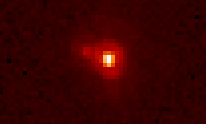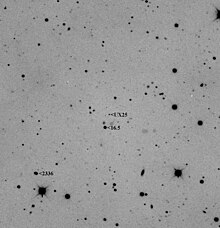(55637) 2002 UX 25
|
Asteroid (55637) 2002 UX 25 |
|
|---|---|

|
|
| Image of 2002 UX 25 and its companion (left) through the Hubble space telescope (2005). | |
| Properties of the orbit ( animation ) | |
| Orbit type | Cubewano («cold») or DO |
| Major semi-axis | 42,492 AU |
| eccentricity | 0.139 |
| Perihelion - aphelion | 36,571 AU - 48,413 AU |
| Inclination of the orbit plane | 19.5 ° |
| Length of the ascending node | 204.7 ° |
| Argument of the periapsis | 278.6 ° |
| Time of passage of the perihelion | December 28, 2066 |
| Sidereal period | 276 a 11.9 M |
| Mean orbital velocity | 4.540 km / s |
| Physical Properties | |
| Medium diameter | 665 ± 29 km companion: 210 ± 30 km |
| Dimensions | 1.25 ± 0.03 · 10 20 kg |
| Albedo | 0.107 + 0.005−0.008 |
| Medium density | 0.82 ± 0.11 g / cm³ |
| Rotation period | 14 h 23 min |
| Absolute brightness | 3.9 likes |
| history | |
| Explorer | Spacewatch |
| Date of discovery | October 30, 2002 |
| Source: Unless otherwise stated, the data comes from JPL Small-Body Database Browser . The affiliation to an asteroid family is automatically determined from the AstDyS-2 database . Please also note the note on asteroid items. | |
(55637) 2002 UX 25 is a large trans-Neptunian object that was discovered on October 30, 2002 by the Spacewatch program. With about 665 kilometers in diameter is (55637) 2002 UX 25 one of the larger Kuiper Belt objects and a potential dwarf planet . In 2007, the discovery of a companion was announced that was about a third the diameter of the mother asteroid.
discovery
(55637) 2002 UX 25 was discovered on October 30, 2002 as part of the Spacewatch project at the Kitt Peak National Observatory.
After its discovery, UX 25 could be identified in photos from October 12, 1991 in 2002 and its orbit calculated relatively precisely. Since then, the asteroid has been observed through various telescopes such as the Hubble , Herschel and Spitzer Space Telescopes, as well as Earth-based telescopes. In January 2018, 212 observations were made over a period of 26 years from 19 oppositions.
properties
Orbit
2002 UX 25 orbits the sun on an elliptical orbit ( orbit eccentricity = 0.139) between 36.57 and 48.41 AU distance. The orbit is inclined 19.47 ° to the ecliptic . The orbit period of 2002 UX 25 is 277.99 years. It will reach perihelion in late 2066. It is currently about 40.6 AU from the Sun.
The Minor Planet Center classifies the object as Cubewano , while Marc Buie ( DES ) classifies it as an extended SDO (DO).
rotation
2002 UX 25 rotates once around its axis in 14.382 hours.
size
The diameter of 2002 UX 25 was calculated to be 681 ± 115 km using data from the Spitzer Space Telescope. This assessment was based on an assumed albedo of 0.115. Combined with examinations by the Herschel telescope, values of 692 ± 23 km (system value) and an albedo of 0.107 + 0.005 were obtained−0.008. Assuming the same albedos for 2002 UX 25 and its satellites, the diameters of the two objects would be 665 ± 29 and 210 ± 30 km.
It is likely that 2002 UX 25 is in hydrostatic equilibrium due to its size and should therefore be largely round. However , it is not entirely certain whether it meets the criteria for classification as a dwarf planet . Mike Brown estimates the asteroid as most likely a dwarf planet.
| year | Dimensions km | source |
|---|---|---|
| 2007 | 681.2 +115.6−114.0 (System) | Stansberry et al. a. |
| 2008 | 680.0 +106.0−108.0 (System) | Brucker et al. a. |
| 2010 | 681.0 | Tancredi |
| 2012 | 705.0 (system) | Mommert et al. a. |
| 2013 | 697.2 +23.0−24.5(System) 665.0 ± 29.0 |
Fornasier et al. a. |
| 2013 | 692.0 ± 23.0 (system) 664.0 |
Brown |
| 2014 | 697.0 ± 35.0 (system) 670.0 ± 34.0 |
Vilenius et al. a. |
| 2017 | 698.0 ± 40.0 (system) 659.0 ± 38.0 |
Brown et al. a. |
| 2017 | 695.0 +30.0−29.0 (System) | Lellouch u. a. |
| 2018 | 704.0 | Brown |
| The most precise determination is marked in bold . | ||
Surface and composition
The reddish spectrum of 2002 UX 25 shows no outstanding features in the visible range and in the near infrared, but has absorption bands in the K-band, which could indicate the presence of methanol compounds on the surface. It is redder than the Varuna , which is roughly the same size - in contrast to the rather greyish 2002 TX 300 , which is similar to the 2002 UX 25 in size and orbit.
With a density of only 0.82 g / cm³, 2002 UX 25 is one of the largest solid celestial bodies in the solar system, the density of which is lower than that of water. Larger Kuiper belt objects should actually have a significant proportion of silicates and metals and thus have a higher density. Should its composition be similar to that of other large KBOs, its internal structure would have to be extremely porous, which seems very unlikely in view of the flowability of water ice. Hence, this low density still amazes astronomers.
moon
In February 2007, a team led by Mike Brown announced the discovery of a moon around 200 km in diameter, which was discovered on the images taken in August 2005. In 2002 it orbited UX 25 in 8.309 days at a distance of 4770 ± 40 km, from which a total system mass of 1.25 ± 0.03 · 10 20 kg can be calculated. The eccentricity of the lunar orbit is 0.17 ± 0.03.
The 2002 UX 25 system at a glance:
| Components | Physical parameters | Path parameters | discovery | |||||
|---|---|---|---|---|---|---|---|---|
| Surname | Throughput diameter (km) |
Relative size % |
Mass (kg) |
Major semi-axis (km) |
Orbital time (d) |
eccentricity |
Inclination to the 2002 UX 25 equator |
Date of discovery Date of publication |
|
(55637) 2002 UX 25 |
665.0 | 100.00 | 1.25 · 10 20 | - | - | - | - | October 30, 2002 2002 |
|
(55637) 2002 UX25 1 (2002 UX 25 I) |
193.0 | 29.02 | ? | 4770 | 8.309 | 0.170 | ? ° | August 26, 2005 February 22, 2007 |
See also
Web links
- How many dwarf planets are there in the outer solar system? Current list of the largest TNOs from Mike Brown
- Free the dwarf planets! Mike Brown's column on the IAU and the dwarf planets regarding their classifications (23 August 2011)
Individual evidence
- ↑ v ≈ π * a / period (1 + sqrt (1-e²))
- ↑ a b c d S. Fornasier, E. Lellouch, T. Müller, P. Santos-Sanz, P. Panuzzo, C. Kiss, T. Lim, M. Mommert, D. Bockelée-Morvan, E. Vilenius, J Stansberry, GP Tozzi, S. Mottola, A. Delsanti, J. Crovisier, R. Duffard, F. Henry, P. Lacerda, A. Barucci, A. Gicquel: “TNOs are Cool”: A survey of the trans- Neptunian region. VIII. Combined Herschel PACS and SPIRE observations of nine bright targets at 70 to 500 μ m . In: Astronomy and Astrophysics . 555, No. A15, 2013, p. 22. arxiv : 1305.0449v2 . bibcode : 2013A & A ... 555A..15F . doi : 10.1051 / 0004-6361 / 201321329 .
- ↑ a b c d Johnston’s Archive: Asteroids with Satellites - (55637) 2002 UX25
- ↑ a b c d e M.E. Brown : The density of mid-sized Kuiper belt object 2002 UX25 and the formation of the dwarf planets . In: The Astrophysical Journal Letters . 778, No. 2, 2013, p. L34. arxiv : 1311.0553 . bibcode : 2013ApJ ... 778L..34B . doi : 10.1088 / 2041-8205 / 778/2 / L34 .
- ↑ (55637) 2002 UX25 in the Small-Body Database of the Jet Propulsion Laboratory (English). Retrieved January 23, 2018.
- ↑ (55637) 2002 UX25 at the IAU Minor Planet Center (English)
- ↑ AstDyS-2. Universita di Pisa, accessed January 23, 2018 .
- ↑ MPEC 2009-C70: Distant Minor Planets (2009 FEB.28.0 TT). Minor Planet Center, February 10, 2009, accessed September 29, 2017 .
- ↑ Marc W. Buie: Orbit Fit and Astrometric record for 55637. SwRI (Space Science Department), accessed September 29, 2017 .
- ^ A b John Stansberry, Will Grundy, Mike Brown, Dale Cruikshank, John Spencer, David Trilling, Jean-Luc Margot: Physical Properties of Kuiper Belt and Centaur Objects: Constraints from Spitzer Space Telescope. (PDF) Retrieved January 23, 2018 . arxiv : astro-ph / 0702538
- ↑ M. Brucker et al. a .: High Albedos of Low Inclination Classical Kuiper Belt Objects (December 2008)
- ^ G. Tancredi: Physical and dynamical characteristics of icy “dwarf planets” (plutoids) . IAU. April 1, 2010. Retrieved January 29, 2019.
- ↑ M. Mommert et al. a .: Remnant planetesimals and their collisional fragments: Physical characterization from thermal-infrared observations (2013)
- ↑ E. Vilenius et al. a .: “TNOs are Cool”: A survey of the trans-Neptunian region. X. Analysis of classical Kuiper belt objects from Herschel and Spitzer observations (April 2014)
- ↑ M. Brown et al. a .: The density of mid-sized Kuiper belt objects from ALMA thermal observations (February 2017)
- ↑ E. Lellouch et al. a .: The thermal emission of Centaurs and Trans-Neptunian objects at millimeter wavelengths from ALMA observations (September 2017)
- ↑ M. Brown : How many dwarf planets are there in the outer solar system? (November 2013)
- ↑ a b Ron Cowen: Astronomers surprised by large space rock less dense than water Kuiper belt object challenges planet-formation theories . In: Nature . November 13, 2013. ISSN 0028-0836 . doi : 10.1038 / nature.2013.14135 . Retrieved September 29, 2017.
